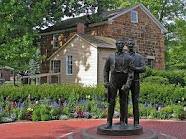In the flurry of all the news activity of the SCOTUS ruling last week, an important date in the Mormon calendar was skipped over. I speak of the 168th anniversary of the martyrdom of the Prophet Joseph Smith (38) and his brother Hyrum (44) on June 27th, 1844.
 |
| Carthage Jail |
Hyrum Smith, the Prophet's older brother, was the first to die instantly as he was hit by four lead balls. At the time of his death he was the assistant president of The Church of Jesus Christ of Latter-day Saints, and also the patriarch to the Church. The Prophet Joseph Smith and Elder John Taylor, a member of the Quorum of the Twelve Apostles were also each struck by four lead balls. We know the exact time of the martyrdom because John Taylor pocket watch stopped when it was struck by one of the balls, and the watch likely saved his life. Some accounts marked the time at 5:21:15 p.m., others at 5:26:16.
Many authors over the years have written their accounts of the martyrdom, but there is nothing to compare with standing or sitting in that room to help one relive those events. I've had that experience on four separate occasions over the years. I can tell you the witness of their divine calling as true prophets never diminishes each time I have gone.
 |
| President John Taylor |
 |
| Elder Willard Richards |
Elder Taylor returned July 2nd to Nauvoo on a sleigh, but the bodies of Joseph and Hyrum were taken to Nauvoo on June 28th.
Those who succeeded the Prophet and Hyrum in their death were their two widows, Emma (40) and Mary Fielding Smith (43). Emma and Joseph had eleven children, including their youngest son, David H. Smith, who was born in November, four months after the Prophet's death. Only five lived to adulthood.
Mary Fielding Smith was the mother of two of Hyrum's eight children, including then five-year-old Joseph F. Smith, future Apostle and eventually a President of the Church.
Two others known by Joseph Smith were among those late arriving on the scene on June 27, 1844: Samuel Smith, his younger brother, and “Sonny,” who first met the Prophet as a young man.
 |
| Elder Joseph B. Wirthlin |
On June 27, 1844, when that stage came through Carthage, Sonny saw a mob gathered around the jail. As passengers got off the stage, the shooting started. Sonny drove the stage to the stable and saw Joseph fall from the jail window.
Samuel, who was one of the eight witnesses to The Book of Mormon, never made it to the Carthage Jail before the martyrdom.
He lived southeast of Nauvoo in nearby Plymouth, Ill., and was on horseback to see his brothers in Carthage. He escaped after being met by members of the mob who chased him through the woods.
Samuel rode back to Nauvoo as part of the fourteen-person bodyguard of Joseph and Hyrum when their bodies were returned to Nauvoo the next day in his wagon. Samuel would succumb and die on July 30th, just a month later as a result of the fatigue from the chase of June 27th. He left behind six children and his death preceded by twenty-one days the birth of his daughter, Lucy J.C.
Other members of the Quorum of the Twelve as well as two future church presidents, Brigham Young and Wilford Woodruff, were on missions in Massachusetts, New York, Michigan, Ohio, Pennsylvania and Nauvoo at the time of the martyrdom.
Elders Taylor and Richards, the only two apostles who were not away on missions, were in the jail cell that day because they willingly chose to accompany the Prophet and Hyrum to Carthage.
 |
| Joseph and Hyrum leave Nauvoo for Carthage |
The Nauvoo Temple has now been reconstructed and was dedicated in 2002. The original temple was completed after Joseph and Hyrum's martyrdom, razed shortly thereafter.
John Taylor's tribute to the brothers concludes:
". . . henceforward their names will be classed among the martyrs of religion; and the reader in every nation will be reminded that the Book of Mormon, and this book of Doctrine and Covenants of the church, cost the best blood of the nineteenth century to bring them forth for the salvation of a ruined world; and that if the fire can scathe a green tree for the glory of God, how easy it will burn up the dry trees to purify the vineyard of corruption. They lived for glory; they died for glory; and glory is their eternal reward. From age to age shall their names go down to posterity as gems for the sanctified." (D&C 135:6).
Thank you so much for this wonderful blog post. It's so important to remember important events like the martyrdom of the Prophet Joseph Smith. I hadn't heard the story of Samuel Smith dying after the martyrdom. That must have been heart-rending to his mother - losing three sons in quick succession. What amazing people the pioneers were to keep moving forward against such terrible persecution. I pray that the world won't repeat these awful mistakes.
ReplyDeleteThanks for your comments, glad you're out there.
ReplyDelete